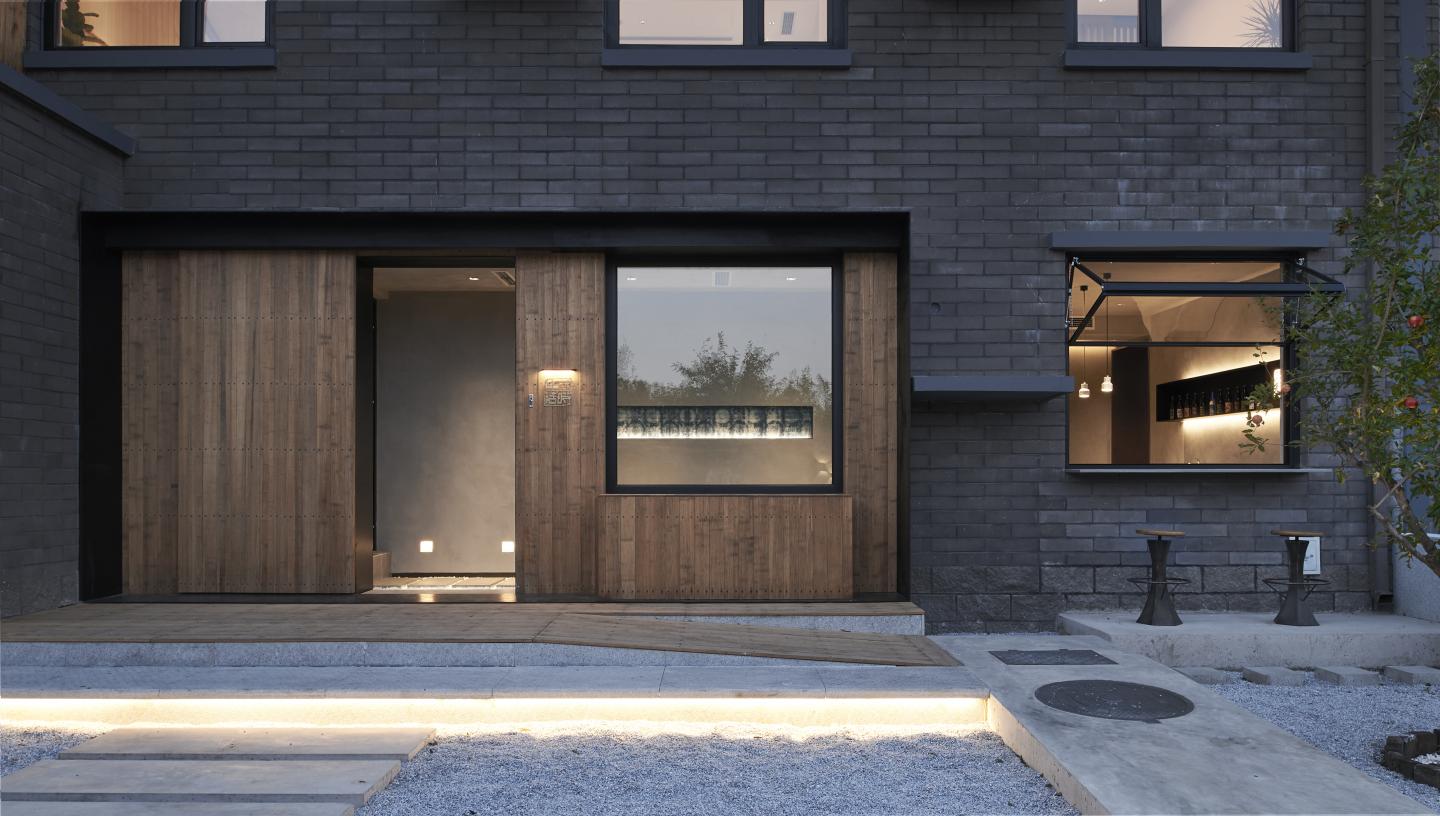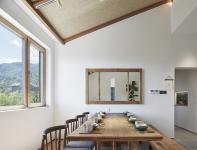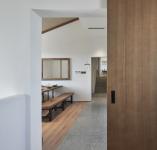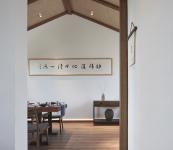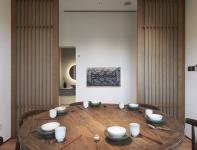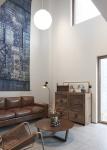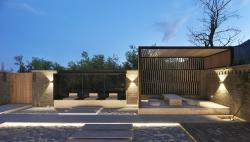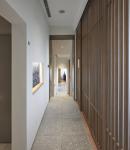T.ETERONO Restaurant
The project base, which is located in the DaXi Mountain Phoenix Range out of the Beijing west sixth ring road, consists of two neighboring private houses with their own independent courtyards. To the south of the base lies a big orchard, through which visitors can enjoy a splendid view of the mountain. The proprietor, who wants to build the whole place into a kind of private restaurant, entrusts Nazodesign Studio to conduct an all-directional innovation renovation on the houses with respect to their inside and outside construction and decoration as well as the landscape surrounding them.
You can easily feel that the houses are already totally deep inside the mountain and forests although it only takes nearly 40 minutes to drive to this place from the city suburbs. So, we hope to utilize simplified design language to deal with the relationship between space and nature by bringing natural scenery into the courtyards and houses. We plan to turn the south yard facade facing the orchard into an area where some outdoor enframed scenery zone and tea zone are arranged in a selectively focusing method, drawing natural light into the area from different angles, to give guests an opportunity to feel and experience nature in the background of diversified lights and shadows.
We will take down the higher parts of the walls of the yards to make the whole area look more delicate, and use cement boards with linear light, old bricks and grey stone fragments as materials for the pavement in the yards. We mean to make the surrounding mountain view the core of everything here by delicately combining human design into nature to create an intimate, homely courtyard.
The whole area will be divided into several functional zones, each with a different height standard, aimed to make some subtle but rich changes in the basic atmosphere of simplicity in the surrounding. Since this is a mountain area, so currently there is a height difference of nearly 1 meter between the two private houses - and then we face a problem of how to get rid of this difference later. We suggest to deal with this problem by tearing down the neighboring wall and building between them a wide staircase which can also serve as outdoor seats in good privacy. So, here, quite unexpectedly, the problem seems to give us an opportunity to create a unique outdoor experience space.
We plan to deliberately arrange the main entrance to the restaurant in a position which is far from the entrance to the yard and leads to some certain space made of pure cement which is then connected to the dining hall- through such a special design, it's aimed to provide all guests a peculiar sense of difficulty that would make their dining experience more colorful and ritual. We believe our guests "drive to the mountain " surely not only to eat food, but also to explore the beautiful natural views here, and to experience the uniqueness, privacy and culture of our enchanting restaurant and courtyard. All the elements of food, mountain view, privacy, space and culture work together to provide guests with a totally new way of dynamic experience of a wonderful world of different materials and rhythms which is gradually unfolding before their eyes as they get closer to and finally enter through the area.
Firstly, the guests cross the spacious yard to go inside the building. At this moment, in front of them is a quite narrow indoor corridor, the floor of which is made of the same kind of cement boards and stone fragments used for the pavement in the yard, this method which diminishes the boundary between the corridor and yard and also makes the whole area look like a quite small grey world full of dramatic imagination.
This corridor is also connected to a bar and reception, beside which sits the side window, which is designed as a vertical foldable sliding one. The corresponding window board is then designed to function as a bar table surface through the frame of the window. When the window is pushed up, the area instantly becomes an outdoor bar. Small parts of the corridor walls will be white on which some works of painting or calligraphy can be hung there, or for an alternative, some pieces of paper of operation concepts.
For the next step, the guests go through the corridor into the first floor public dining area which is a process with noticeable change in space rhythm. Currently each house has a very limited height and we plan to remove the second storey's floor of the lower house to make its two storeys into one. In that way, the guests would surely have a marvelous experience when they walk into a very spacious space with a height of about 7 meters from a narrow corridor.
The pure white staircase of extreme simplicity functions as an important transition from the quite modern first storey into the very elegant and simple second storey.
The second storey is mostly dining space and consists of different areas of public dining zones and private rooms for the needs of different guests, which are also designed to suit the original construction characteristics of the houses.
The south wall in the shape of slope on the second storey will be preserved, through the windows on which, you can see a very nice view over the mountain. We will cover the inner surface of the slope wall with bamboo mat to make it look ancient and classic and in good match with the beautiful outside scenery.
Our design concept is to develop a variety of space levels which will make up a series of enframed sceneries. In these different spaces, some openings are set there to serve as the frame of each scenery. For designing of such openings, we take guests' usual perspectives as our basic guidance. All openings are developed into vivid unique shapes with no notch so as to make them function as excellent frames for their sceneries.
On all the walls of the houses, we mainly use wooden slide doors and some kind of invisible doors in order to strengthen the wholeness of the area.
The proprietor has a large collection of some quality ancient cloth. And we're considering to use them for decorating the houses in some suitable and delicate method. The adding of soft material for decoration is likely to make the general atmosphere in the whole area more gentle and intimate, and also to improve the space quality here.
The skirtings we will use for decoration are made of black steel and only 2 cm high.
And we will use fine copper bars as joint sealers between each floor tile. The walls of the exhibition recess part will be made with fine and smooth black perfluorocarbon steel sheet in order to create a sense of space delicacy. The combination of deliberately made old copper sheets and coarse cement walls is meant to present a simple but quality space full of both modern and traditional features.
After the entire project is completed, a perfect modernness as well as integration with the nature will be demonstrated in the whole area, which we are passionately looking forward to. We think we need to make a deep level response to our surroundings without changing our life styles and aesthetic habits at the same time- that is also our way of understanding placeness.
2018
2018
1.Wooden bamboo —Zhuyuan Tech
2.White paint - Benjamin Moore
3.Old cloth-T.ETERNO
Project: T.ETERNO Restaurant
Client: T.ETERNO
Produce:Jiang Chengcheng
Area: 520 sqm
Completion date: September 2018
Design:Nazodesign Studio
Project team: Tian Shaoyin, Zeng Yuxian,Guo YiKe , Zhang Zengquan
Landscape:Mayue
Kitchen:Jinxin
Luminaire:Mercanvee,BENTU
Construction:ShangDong
Photography:Misae Hiromatsu, Yuming Song (Beijing Ruijing Photo)
Contact:[email protected]
